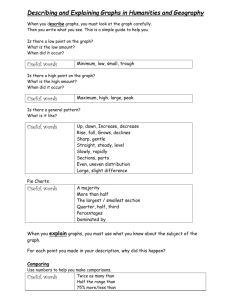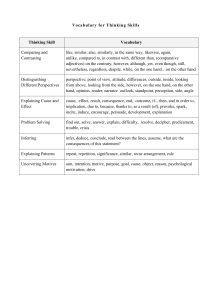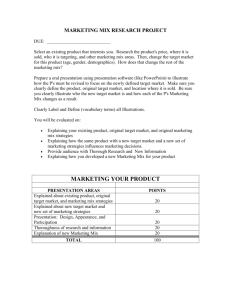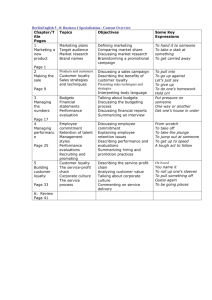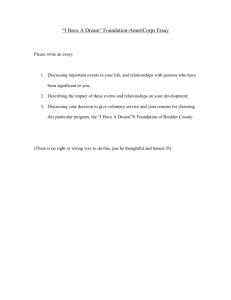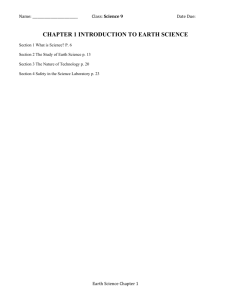instructional package - Horry Georgetown Technical College
advertisement
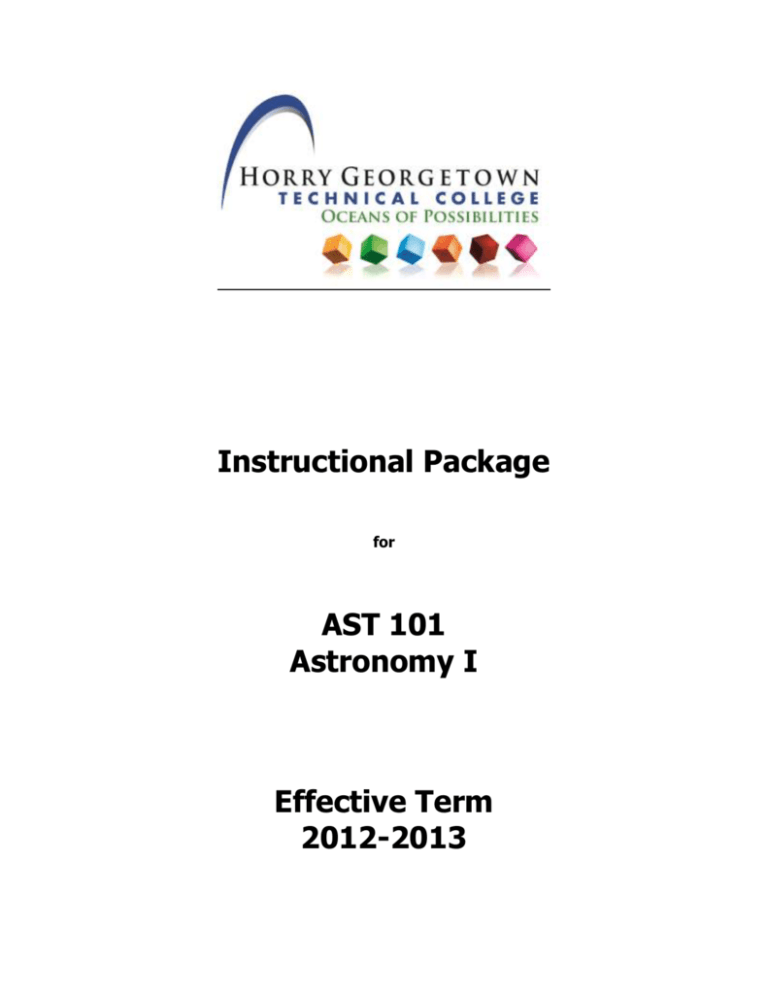
Instructional Package for AST 101 Astronomy I Effective Term 2012-2013 INSTRUCTIONAL PACKAGE Effective Term: Fall 2012-2013 COURSE PREFIX: AST-101 COURSE TITLE: Solar System Astronomy CONTACT HOURS: 6 CREDIT HOURS: 4 RATIONALE FOR THE COURSE: This university transfer course satisfies requirements for AA and AS degrees at Horry-Georgetown Technical College. COURSE DESCRIPTION: This course is an introduction to basic astronomy with emphasis being placed on planets and moons associated with our solar system. The newest technology used in the accumulation of astronomical data is of special importance and will be covered as well. PREREQUISITES: “C” or Better in MAT 155 or COMPASS PRE-ALG score of at least 60 or SAT MATH score of at least 401 or ACT MATH score of at least 18 I REQUIRED MATERIALS: Please visit the Bookstore online site for most current textbook information. Use the direct link below to find textbooks. http://hortec.bncollege.com/webapp/wcs/stores/servlet/TBWizardView?catalogId=10001&langId =-1&storeId=51560. Enter the semester, course prefix, number and section and it will take you to the correct textbook. SSTC The SSTC is an excellent place for you to go if you need help. The SSTC offers to all students the following free resources: 1. Student and professional tutors (appointments recommended) for most major subject areas 2. Writing Center Support Services (appointments recommended) for writing, reading, and basic English developmental skills 3. Student success, academic, and technology support resources a. Online Resource Center (www.hgtc.edu/sstclinks) b. DVDs for Test Taking Strategies and Writing Skills c. Reading Comprehension, Time Management or Study Skills Packets d. Microsoft Office 2010 Guides e. D2L Guides f. And Much More…. 4. Workshops on college success skills, technology, and D2L for online courses 5. General technology assistance The SSTC wants you to have the opportunity to use the free resources that they offer to students in house and online on their website: www.hgtc.edu/sstc. To schedule a tutoring session or appointment with staff, please call one of the following locations: SSTC Conway, 349-7872; SSTC Grand Strand, 4772113; and SSTC Georgetown, 520-1455. Room locations are posted on the SSTC website. Academic Dishonesty/Cheating All forms of academic dishonesty, as outlined in the Student Code in the HGTC catalog, will NOT be tolerated and will result in disciplinary action. Anyone caught cheating or committing plagiarism (Defined in the code as: “The appropriation of any other person’s work and the unacknowledged incorporation of that work in one’s own work offered for credit”) will be given a grade of a zero for that assignment and reported to the Senior VP of Academic Affairs, in accordance with the student handbook. A second offense will result in the student being withdrawn from the course with a “WF” and charges being filed with the Chief Student Services Officer. HGTC ATTENDANCE REQUIREMENTS: Horry-Georgetown Technical College maintains a general attendance policy requiring students to be present for a minimum of eighty percent (80%) of his or her classes in order to be eligible to receive credit for any course. However, due to the varied nature of courses taught at the college, a more rigid attendance policy may be required by individual instructors. At a minimum, a student may be withdrawn from a course(s) after he or she has been absent in excess of ten percent (10%) of the total contact hours for a course. Instructors define absentee limits for their class at the beginning of each term. COURSE OUTLINE Unit 1 Chapter 1 – Charting the Heavens Chapter 2 – The Copernican Revolution Chapter 3 - Radiation Chapter 4 – Spectroscopy Test #1 Unit 2 Chapter 5 - Telescopes Chapter 6 – The Solar System Chapter 7 - Earth Chapter 8 – The Moon and Mercury Test #2 Unit 3 Chapter 9 - Venus Chapter 10 - Mars Chapter 11 - Jupiter Chapter 12 – Saturn Test #3 Unit 4 Chapter 13 – Uranus and Neptune Chapter 14 – Solar System Debris Chapter 15 – The Formation of Planetary Systems Final Exam EVALUATION OF REQUIRED COURSE MEASURES/ARTIFACTS 4 regular semester tests Labs and Projects Homework Quizzes -60% -20% -10% -10% 100% GRADING SYSTEM: 90-100 A 80-89.9 B 70-79.9 C 60-69.9 D <60 F Grades earned in courses impact academic progression and financial aid status. Before withdrawing from a course, be sure to talk with your instructor and financial aid counselor about the implications of that course of action. Ds, Fs, Ws, WFs and Is also negatively impact academic progression and financial aid status. The Add/Drop Period is the first 5 days of the semester for full term classes. Add/Drop periods are shorter for accelerated format courses. The following week of the semester is Financial Aid Attendance Verification period. You must attend at least one meeting of all of your classes during that period. If you do not, you will be dropped from the course(s) and your Financial Aid will be reduced accordingly. Students should refer to an Instructor’s Individual Information Sheets for more specific information on testing policies, grading, make-up policy, attendance policies, etc. COURSE LEARNING OUTCOMES Listed below are the student learning outcomes for this course. These learning outcomes define what knowledge and skills a student will possess after successful completion of this course. Chapter 1: Charting the Heavens – The Foundations of Astronomy A student will be able to describe the basics terminology of astronomy by: Describing how scientists combine observation, theory, and testing in their study of the universe. Explaining the concept of the celestial sphere and how we use angular measurement to locate objects in the sky. Describing how and why the Sun and the stars appear to change their positions from night to night and from month to month. Explaining why Earth’s rotation axis shifts slowly with time, and saying how this affects Earth’s seasons. Showing how the relative motions of Earth, the Sun and the Moon lead to eclipses. Explaining the simple geometric reasoning that allows astronomers to measure the distances and sizes of otherwise inaccessible objects. Chapter 2: The Copernican Revolution – The Birth of Modern Science A student will be able to state his knowledge of the early history of astronomy by: Describing how some ancient civilizations attempted to explain the heavens in terms of Earthcentered models of the universe. Explaining how the observed motions of the planets led to our modern view of a Sun-centered solar system. Describing the major contributions of Galileo and Kepler to our understanding of the solar system. Stating Kepler’s laws of planetary motion. Explaining how astronomers have measured the true size of the solar system. Stating Newton’s laws of motion and universal gravitation and explaining how they account for Kepler’s laws. Explaining how the law of gravitation enables us to measure the masses of astronomical bodies. Chapter 3: Radiation – Information from the Cosmos A student will be able to demonstrate their knowledge of electromagnetic radiation by: Describing the basic properties of wave motion. Telling how electromagnetic radiation transfers energy and information through interstellar space. Describing the major regions of the electromagnetic spectrum and explaining how Earth’s atmosphere affects our ability to make astronomical observations at different wavelengths. Explaining what is meant by the term “blackbody radiation” and describing the basic properties of such radiation. Telling how we can determine the temperature of an object by observing the radiation that it emits. Showing how the relative motion of a source of radiation and its observer can change the perceived wavelength of the radiation, and explain the importance of this phenomenon to astronomy. Chapter 4: Spectroscopy – The Inner Workings of Atoms A student will be capable of explaining the structure and workings of atoms by: Describing the characteristics of continuous, emission, and absorption spectra and the conditions under which each is produced. Explaining the relation between emission and absorption lines and what we can learn from those lines. Specifying the basic components of the atom and describing our modern conception of its structure. Discussing the observations that led scientists to conclude that light has particle as well as wave properties. Explaining how electron transitions within atoms produce unique emission and absorption features in the spectra of those atoms. Describing the general features of spectra produced by molecules. Listing and explaining the kinds of information that can be obtained by analyzing the spectra of astronomical objects. Chapter 5: Telescopes – The Tools of Astronomy A student will be able to demonstrate their knowledge of telescopes by: Sketching and describing the basic designs of optical telescopes used by astronomers. Explaining the particular advantages of reflecting telescopes for astronomical use, and specifying why very large telescopes are needed for most astronomical studies. Explaining the purpose of some of the detectors used in astronomical telescopes. Describing how Earth’s atmosphere affects astronomical observations, and discussing some of the current efforts to improve ground-based astronomy. Discussing the relative advantages and disadvantages of radio and optical astronomy. Explaining how interferometry can enhance the usefulness of astronomical observations. Explaining why some astronomical observations are best done from space, and discussing the advantages and limitations of space-based astronomy. Saying why it is important to make astronomical observations in different regions of the electromagnetic spectrum. Chapter 6: The Solar System – An Introduction to Comparative Planetology A student will be able to explain why comparative planetology is used in describing other planet or planetary systems by: Discussing the importance of comparative planetology to solar system studies. Describing the overall scale and structure of the solar system. Summarizing the basic differences between the terrestrial and the jovian planets. Identifying and describing the major non-planetary components of the solar system. Describing some of the spacecraft missions that have contributed significantly to our knowledge of the solar system. Chapter 7: Earth – Our Home in Space A student will be able to describe the physical nature of Earth by: Summarizing the physical properties of planet Earth. Explaining how Earth’s atmosphere helps to heat us, as well as protect us. Outlining our current model of Earth’s interior and describing some of the experimental techniques used to establish the model. Summarizing the evidence for the phenomenon of “continental drift” and discussing the physical process that drives it. Discussing the nature and origin of Earth’s magnetosphere. Describing how both the Moon and the Sun influence Earth’s surface and affect our planet’s spin. Chapter 8: The Moon and Mercury – Scorched and Battered Worlds Students will comprehend the similarities and differences between these two bodies by: Specifying the general characteristics of the Moon and Mercury and comparing them with those of Earth. Describing the surface features of the Moon and Mercury, and recounting how those two bodies were formed by events early in their history. Explaining how the Moon’s rotation is influenced by its orbit around Earth, and Mercury’s by its orbit around the Sun. Explaining how observations of cratering can be used to estimate the age of a body’s surface. Describing the evidence for ancient volcanism on the Moon and Mercury. Comparing the Moon’s interior structure with that of Mercury. Summarizing the leading theory of the formation of the Moon. Discussing how astronomers have pieced together the story of the Moon’s evolution, and comparing its evolutionary history with that of Mercury. Chapter 9: Venus – Earth’s Sister Planet Students will be able to describe Venus by: Summarizing Venus’s general orbital and physical properties. Describing the characteristics of Venus’s atmosphere and contrasting it with that of Earth. Comparing the large-scale surface features and geology of Venus with those of Earth and the Moon. Discussing the evidence for ongoing volcanic activity on Venus. Explaining why the greenhouse effect has produced conditions on Venus very different from those on Earth. Describing Venus’s magnetic field and internal structure. Chapter 10: Mars – A Near Miss for Life? A student will be able to describe Mars by: Summarizing the general orbital and physical properties of Mars. Describing the observational evidence for seasonal changes on Mars. Comparing the surface features and geology of Mars with those of the Moon and Earth, and accounting for these characteristics in terms of Martian history. Discussing the evidence that Mars once had a much denser atmosphere and running water on its surface. Explaining where that ancient water on Mars may be found today. Comparing the atmosphere of Mars with those of Earth and Venus, and explaining why the evolutionary histories of these three worlds diverged so sharply. Discussing what is known of the internal structure of Mars. Describing the characteristics of Mars’s moons and explaining their probable origin. Chapter 11: Jupiter – Giant of the Solar System A student will be able to describe Jupiter by: Specifying the ways in which Jupiter differs from the terrestrial planets in its physical and orbital properties. Discussing the processes responsible for the appearance of Jupiter’s atmosphere. Describing Jupiter’s internal structure and composition, and explaining how their properties are inferred from external measurements. Summarizing the characteristics of Jupiter’s magnetosphere. Discussing the orbital properties of the Galilean moons of Jupiter, and describing the appearance and physical properties of each moon. Explaining how tidal forces can produce enormous internal stresses in a jovian moon, and discussing some effects of those stresses. Chapter 12: Saturn – Spectacular Rings and Mysterious Moons A student will be able to describe Saturn by: Summarizing the orbital and physical properties of Saturn, and comparing them with those of Jupiter. Describing the composition and structure of Saturn’s atmosphere and interior. Explaining why Saturn’s internal heat source and magnetosphere differ from those of Jupiter. Describing the structure and composition of Saturn’s rings. Defining the Roche limit, and explaining its relevance to the origin of Saturn’s rings. Summarizing the general characteristics of Titan, and discussing the chemical processes in its atmosphere. Discussing some of the orbital and geological properties of Saturn’s smaller moons. Chapter 13: Uranus and Neptune – The Outer Worlds of the Solar System A student will be able to describe Uranus and Neptune by: Describing how both chance and calculation played major roles in the discoveries of the outer planets. Summarizing the similarities and differences between Uranus and Neptune, and comparing these planets with the other two jovian worlds. Describing what is known about the interiors of Uranus and Neptune. Explaining what the moons of the outer planets tell us about their past. Contrasting the rings of Uranus and Neptune with those of Jupiter and Saturn. Chapter 14: Solar System Debris – Keys to Our Origin A student will be able to describe the remnants of solar system formation by: Describing the orbital properties of the major groups of asteroids. Summarizing the composition and physical properties of a typical asteroid. Detailing the composition and structure of a typical comet, and explaining the formation and appearance of its tail. Discussing the characteristics of cometary orbits and what they tell us about the probable origin of comets. Describing the solar system beyond Neptune, and explaining why astronomers no longer regard Pluto as a planet. Distinguishing among the terms meteor, meteoroid, and meteorite. Summarizing the orbital and physical properties of meteoroids, and explaining what these properties suggest about the probable origin of meteoroids. Chapter 15: The Formation of Planetary Systems – The Solar System and Beyond A student will be able to describe the process of solar system formation by: Explaining how the terrestrial planets formed. Discussing the leading theories for the formation of the jovian worlds. Describing how comets and asteroids formed, and explaining their role in determining planetary properties. Discussing some techniques astronomers use to detect planets beyond the solar system. Outlining the properties of known extrasolar planets. Discussing how extrasolar planets fit in with current theories of solar system formation.

